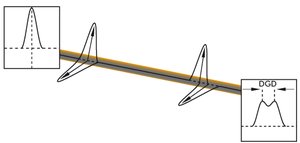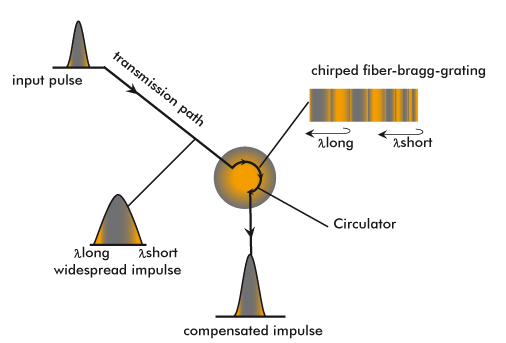
Intermodal dispersion

With a correspondingly large cross section, a signal is reflected between the core and the cladding of the fiber. The group velocity of light propagating in a multimode fiber depends also on the propagation of different modes (Differential Mode Delay). This lead to a broadening of the signal.
Polarization mode dispersion

Optical fiber show the effect of birefringent, caused by external influences such as bending, torsion, as well as inhomogenety of the core. This results to different propagation velocities for the two orthogonal polarization states (Differential Group Delay) and therefore in a pulse broadening. A reduction of this effect can be achieved, as far as possible, by an exact geometry of the fiber. External influences are minimized by careful handling during installation of the fiber.
Four-wave-mixing
It can occur that three different frequency components propagate together in a an optical fiber, creating a fourth frequency component. Similar to cross-talk - these four different frequency components interact via four-wave mixing with neighboured ones. This effect is reduced in the event of non-zero chromatic dispersion of the fiber. If all four different components A degenerate four-wave mixing occours, where the frequencies coincide.
Chromatic dispersion

The chromatic dispersion describes the phenomenon that the group velocity of light propagating in a fiber depend on the optical frequency. The resulting differential group delay between different frequency components lead to a distortion of the received signal and a limitation of distances in a DWDM network. This effect is well handled by various methods.
Chromatic dispersion and use of fiber-bragg-gratings for compensation

Chromatic dispersion can be compensated by various techniques, e.g. by the use of an fiber-bragg-grating. In principle a fiber-bragg-grating chance its refractive index with penetration depth of light. An incoming pulse that is broadened, the different spectral components travels on different paths within the grating.
The resulting time delay results in a narrowing of the pulse and thus to a compensation of the chromatic dispersion.
F-tone Networks是国际成熟的光通信方案解决商,致力提供高端品牌SFP,XFPGE SFP,10G SFP,BIDI SFP以及SFP Module与QSFP研发,生产,制造;我们的愿景让网络更快速,稳定! 咨询热线:028-65381606